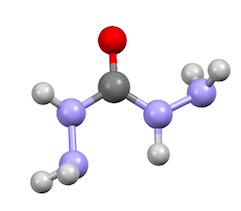
| |

| |
| Names | |
|---|---|
| IUPAC name
1,3-Diaminourea
| |
| Other names
Carbohydrazine
| |
| Identifiers | |
3D model (JSmol)
|
|
| ChEBI | |
| ChemSpider | |
| ECHA InfoCard | 100.007.126 |
| EC Number |
|
PubChem CID
|
|
| UNII | |
CompTox Dashboard (EPA)
|
|
| |
| |
| Properties | |
| CH6N4O | |
| Molar mass | 90.09 g/mol |
| Density | 1.341 g/cm3 |
| Melting point | 153–154 °C (307–309 °F; 426–427 K) |
Except where otherwise noted, data are given for materials in their standard state (at 25 °C [77 °F], 100 kPa).
| |
Carbohydrazide is the chemical compound with the formula OC(N2H3)2. It appears as a white solid that is soluble in water,[1][2] but not in many organic solvents, such as ethanol, ether or benzene. It decomposes upon melting.[2] A number of carbazides are known where one or more N-H groups are replaced by other substituents. They occur widely in the drugs, herbicides, plant growth regulators, and dyestuffs.
Production[edit]
Industrially the compound is produced by treatment of urea with hydrazine:[3]
- OC(NH2)2 + 2 N2H4 → OC(N2H3)2 + 2 NH3
It can also be prepared by reactions of other C1-precursors with hydrazine, such as carbonate esters.[2] It can be prepared from phosgene, but this route cogenerates the hydrazinium salt [N2H5]Cl and results in some diformylation. Carbazic acid is also a suitable precursor:
- N2NH3CO2H + N2H4 → OC(N2H3)2 + H2O
Structure[edit]
The molecule is nonplanar. All nitrogen centers are at least somewhat pyramidal, indicative of weaker C-N pi-bonding. The C-N and C-O distances are about 1.36 and 1.25 Å, respectively.[4]
Industrial uses[edit]
- Oxygen scrubber: carbohydrazide is used to remove oxygen in boiler systems. Oxygen scrubbers prevent corrosion.[5][6]
- Precursor to polymers: carbohydrazide can be used as a curing agent for epoxide-type resins.[2]
- Photography: carbohydrazide is used in the silver halide diffusion process as one of the toners. Carbohydrazide is used to stabilize color developers that produce images of the azo-methine and azine classes.[2]
- Jet fuel: carbohydrazine can be used as a component in jet fuels, as a large amount of heat is being produced when the material is burned.
- Carbohydrazide has been used to develop ammunition propellants,[7] stabilize soaps,[2] and is used as a reagent in organic synthesis.
- Salts of carbohydrazide, such as nitrate, dinitrate and perchlorate, can be used as secondary explosives.[8] Complex salts of carbohydrazide, like bis(carbohydrazide)diperchloratocopper(II) and tris(carbohydrazide)nickel(II) perchlorate, can be used as primary explosives in laser detonators.[9]
Hazards[edit]
Heating carbohydrazide may result in an explosion. Carbohydrazide is harmful if swallowed, irritating to eyes, respiratory system, and skin. Carbohydrazide is toxic to aquatic organisms.[10]
References[edit]
- ^ Inorganic Syntheses Volume IV. McGraw-Hill Book Company, Inc. 1953. p. 35. ISBN 9780470132678.
- ^ a b c d e f Kurzer, Frederick; Michael Wilkinson (February 1970). "Chemistry of carbohydrazide and thiocarbohydrazide". Chemical Reviews. 70 (1): 111–149. doi:10.1021/cr60263a004. PMID 4391877.
- ^ Jean-Pierre Schirmann, Paul Bourdauducq "Hydrazine" in Ullmann's Encyclopedia of Industrial Chemistry, Wiley-VCH, Weinheim, 2002. doi:10.1002/14356007.a13_177.
- ^ Ottersen, T.; Hope, H. "The Structure and Electron Deformation Density Distribution of Carbonohydrazide (Carbohydrazide) at 85 K" Acta Crystallographica B 1979, volume 35, p373-p378. doi:10.1107/S0567740879003575
- ^ Buecker, Brad (1997). Power Plant Water Chemistry A Practical Guide. PennWell Publishing Company. pp. 13–16. ISBN 978-0-87814-619-2.
- ^ "Patent US4269717". Retrieved 8 October 2012.
- ^ "Patent US2970899". Retrieved 8 October 2012.
- ^ Fischer, Niko; Klapötke, Thomas M.; Stierstorfer, Jörg (June 2011). "Explosives Based on Diaminourea". Propellants, Explosives, Pyrotechnics. 36 (3): 225–232. doi:10.1002/prep.201100001. S2CID 97871632.
- ^ Joas, Manuel; Klapötke, Thomas M. (April 2015). "Laser Initiation of Tris(carbohydrazide)metal(II) Perchlorates and Bis(carbohydrazide)diperchloratocopper(II)". Propellants, Explosives, Pyrotechnics. 40 (2): 246–252. doi:10.1002/prep.201400142.
- ^ "MSDS". Retrieved 8 October 2012.
Well, that’s interesting to know that Psilotum nudum are known as whisk ferns. Psilotum nudum is the commoner species of the two. While the P. flaccidum is a rare species and is found in the tropical islands. Both the species are usually epiphytic in habit and grow upon tree ferns. These species may also be terrestrial and grow in humus or in the crevices of the rocks.
View the detailed Guide of Psilotum nudum: Detailed Study Of Psilotum Nudum (Whisk Fern), Classification, Anatomy, Reproduction